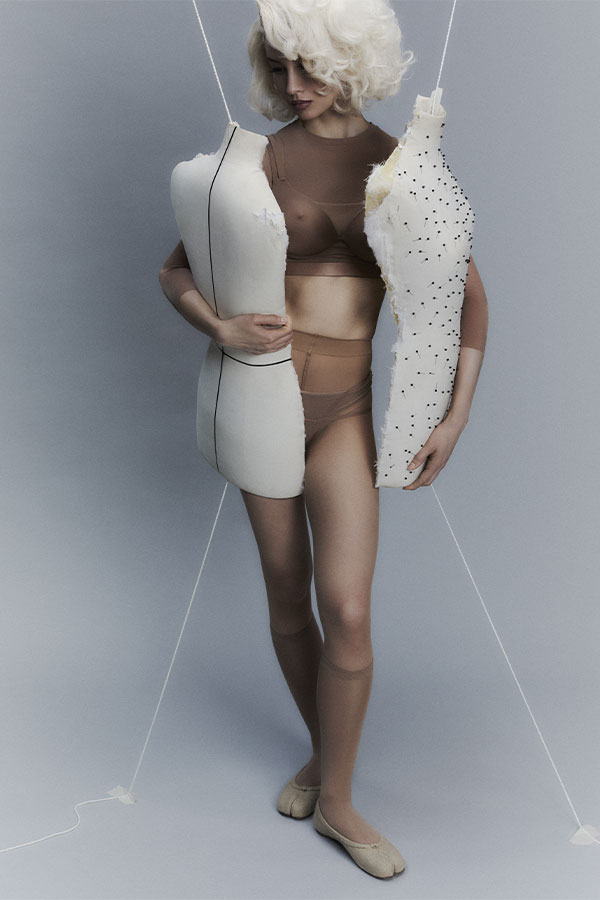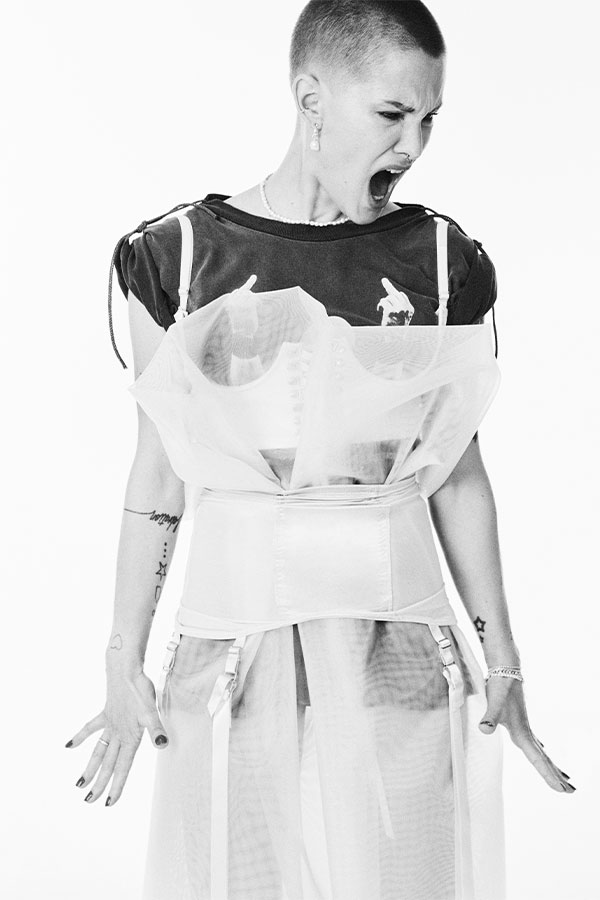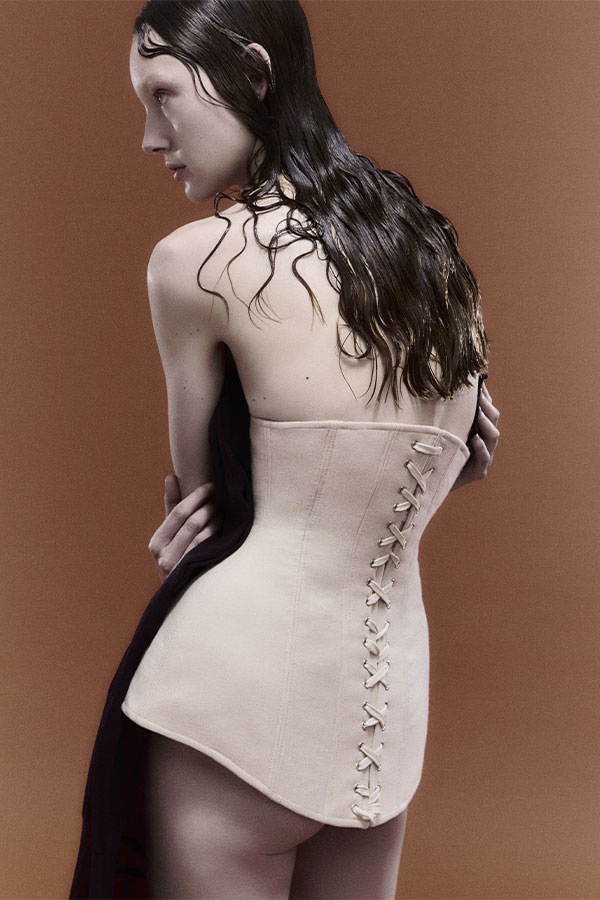


Mentored by Sissy Vian, three rising fashion stylists reveal how the corset, once restrictive, now transforms into a symbol of empowerment
What exactly is a corset, and what potential does this once-cage, now reinvented as a symbol of freedom, hold? Throughout history, it has symbolised various ideals and standards, evolving significantly over the centuries. So, what’s sparked its revival in contemporary fashion, bringing this restrictive garment back into vogue on red carpets and runways in a world that claims to crave freedom from constraints? Zendaya and Maison Margiela by John Galliano, we’re looking at you. How has this once-confining item been updated to the cutting edge of fashion innovation?

Final photoshoot by student Gwyneth Olimpia Sabau, one of the three winners of the contest for Sissy Vian's Mentorship in the Fashion Styling, Creative Direction & Digital Content course at Istituto Marangoni Milano
Enter the new talents, particularly three emerging fashion stylists: Alessandro Etna, Teresa Frankovich, and Gwyneth Sabau, winners of the Mentorship Programme led by Sissy Vian, one of the most influential stylists and the Creative Fashion Director of Harper’s Bazaar Italia. Vian mentored the students of the Master’s in Fashion Styling, Creative Direction & Digital Content for the second consecutive year at Istituto Marangoni Milano. She challenged them to create a photo shoot styling that captured the mannerisms of the corset and the doll, providing a personal interpretation responding to the theme of the “New Aesthetic.”
For the second consecutive year, Sissy Vian mentored students in the Master’s programme in Fashion Styling, Creative Direction & Digital Content at Istituto Marangoni Milano. She challenged them to create a styling that embodied the essence of both the corset and the doll
Once feared as a tool of sartorial torture, the corset has transformed over the centuries from a symbol of oppression to an icon of style and power. Almost oxymoronic, the corset has shed its original function to become today’s emblem of female emancipation, self-discovery, and celebration of the body in all its forms, taking centre stage in the latest collections of famous designers. Today, it’s not just a garment – it’s a bold statement of femininity, a cult wardrobe essential cherished by fashionistas worldwide. Who would have imagined that this 18th-century tool of torture would be revived, revitalised, and embraced by modern fashion lovers?
The Dark Past of the Corset
The corset made a relatively late appearance in Western clothing history, though some form of bodice was likely used in antiquity.
During the Classical period, women primarily wore loose and comfortable garments like tunics. It was not until the 13th and 14th centuries, when the so-called anatomical fashion emerged among the urban bourgeoisie, that clothing began to emphasise the body and distinctly differentiate between male and female attire. The modern corset era started during the Renaissance in Europe and was popular among high-society ladies. The design of this garment changed many times over the years, but its basic structure remained the same: a fabric bodice with whalebone supports, which could cover the entire torso or just the waist, tightened with laces.

Final photoshoot by student Theresa Frankovich, one of the three winners of the contest for Sissy Vian's Mentorship in the Fashion Styling, Creative Direction & Digital Content course at Istituto Marangoni Milano.
But it was during the 17th and 18th centuries that the corset became a tool of oppression, designed to shape the female body according to beauty standards that now seem unreasonable. Women were tightly cinched into whalebone, laces, and stays, sacrificing comfort and often their health to conform to an unrealistic ideal of perfection. It was the era of the “wasp waist,” when deep breathing was a luxury, and fainting at balls was commonplace.
The Emancipation Journey
The 20th century saw the decline of the corset as everyday wear. This was partly due to the sartorial revolution led by influential designers like Coco Chanel, who championed more comfortable fashion that looked elegant without sacrificing comfort. The 1920s Flappers also rejected the corset as they rebelled against social and fashion norms. However, the corset continued to have a presence in theatre, cinema, and women’s lingerie fashion.

Final photoshoot by student Alessandro Etna, a winner of the contest for Sissy Vian's Mentorship in the Fashion Styling, Creative Direction & Digital Content course at Istituto Marangoni Milano
In the 1980s and 1990s, the corset made a triumphant return to the fashion scene, reimagined by visionary designers like Vivienne Westwood and Jean-Paul Gaultier. No longer (just) a symbol of constraint, it became an emblem of strength and sensuality. Westwood turned it into a key piece in her collections, boldly and irreverently highlighting feminine forms, while Gaultier, with his iconic cone bra for Madonna, redefined the corset’s imagery, making it an avant-garde garment.
And just like that, we find ourselves at the women’s runways of Dolce & Gabbana and Andreas Kronthaler for Vivienne Westwood or enjoying the music scene with the rock-dandy armour of Lenny Kravitz and Damiano from Måneskin. Fast forward to the 2023 Oscars, Gen Z’s Halle Bailey, the star of The Little Mermaid, looked stunning in her sheer corset gown. And who could forget the 2022 Met Gala, where Billie Eilish wowed us in an eco-friendly corset dress by Gucci’s Alessandro Michele? It was so Regencycore, so Bridgerton. Well done, Billie!
An Ever-Present Accessory
The corset is an enduring mystery, evolving from a high-society must-have to a symbol of inclusivity and activism. Its history is far from static, and Maison Margiela Artisanal 2024 by John Galliano is the latest evidence of its lasting appeal.
Over the years, the corset has been reimagined, constantly adapting to new aesthetics. This reimagination was also at the core of the “New Aesthetic” Mentorship Programme by Sissy Vian at Istituto Marangoni Milano.
From Red Carpet to Street Style: Today’s Corset Obsession
Today, the corset has stormed runways, star-studded events, and everyday street style. Celebrities like Kim Kardashian, Rihanna, and Bella Hadid have embraced it with pride, showing that the corset can be both chic and casual. Some use it to accentuate jaw-dropping silhouettes, while others push its boundaries, exploring new stylistic horizons.
In essence, it’s a dance between past and present, a balance between structure and freedom. The younger generation doesn’t wear it to blend in but to stand out and express their individuality in a world that celebrates diversity. Take rapper BigMama, who made waves at the 2024 Italian song festival Sanremo with outfits by Lorenzo Seghezzi—a designer who transforms corsets into symbols of liberation, crafting a vision that defies traditional gender norms.
Rebirth and Reimagination
Sissy Vian perfectly embodied the role of mentor, guiding young fashion stylists with her creative vision. She encouraged them to see the corset not just as a garment but as a canvas for expressing personal ideas and narratives, following its contemporary allure and adaptability. With her creative insight, Vian inspired the emerging fashion stylists of Istituto Marangoni Milano to push beyond conventional boundaries and explore new forms and functions of the corset.
We can confidently declare that what was once a symbol of confinement—now depicted in historical dramas—has been reimagined as a symbol of freedom, proudly parading the streets with a fresh new attitude. The corset has undergone a bold transformation, shedding its restrictive past to become a symbol of empowerment. “Fashion isn’t static; it evolves with society, weaving ever-changing tales of transformation, strength, and beauty. As Sissy Vian puts it, fashion is a story of evolution.
Agnese Pasquinelli
Fashion Business, Digital Communication & Media alumna, Milan



